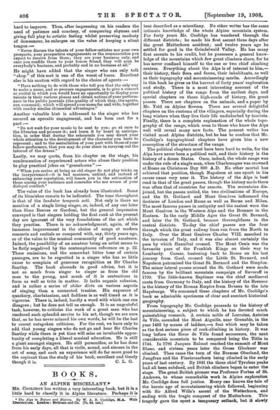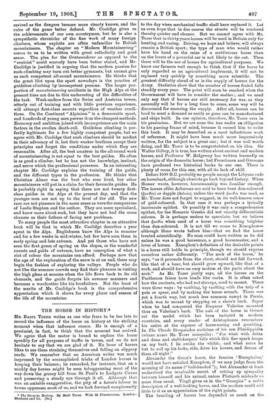BOOKS.
AN ALPINE MISCELLANY.* Mn. COOLIDGE has written a very interesting book, but it is a little hard to classify it in Alpine literature. Perhaps it is • The Alps in Nature and History. By W. A. B. Coolidge, M.A. With Illustrations. London : Methuen and Co. CM. 6d. net.l
best described as a miscellany. No other writer has the same intimate knowledge of the whole Alpine mountain system.
For forty years Mr. Coolidge has wandered through the different districts ; he made his first ascent three days after the great Matterhorn accident; and twelve years ago he settled for good in the Grindelwald Valley. He has many first ascents to his credit, but he possesses a general know- ledge of the mountains which few great climbers share, for he has never confined himself to the one or two chief climbing centres. Everything about the Alps is of interest to him,—
their history, their flora and fauna, their inhabitants, as well as their topography and mountaineering merits. Accordingly in this book he gives us the harvest of forty years' exploration and study. There is a most interesting account of the political history of the range from the earliest days, and special chapters on those high-roads of history, the great passes. There are chapters on the animals, and a paper by Mr. Yeld on Alpine flowers. There are several delightful chapters on the customs of the villagers, especially during the long winters when they live their life undisturbed by tourists. Finally, there is a complete explanation of the whole topo- graphy of the range, which even to those who know the Alps well will reveal many new facts. The present writer has visited most Alpine districts, but he has to confess that Mr. Coolidge's topographical chapters have given him a new conception of the structure of the range.
The political chapters must have been hard to write, for the Alps have never been a political unit, and their history is the history of a dozen States. Once, indeed, the whole range was under the rule of a single man, when Charlemagne was crowned at Rome on Christmas Day 800 A.D. No other mortal has achieved that position, though Napoleon at one epoch in his
career came very near it. The history of the Alps is beat read in that of the great passes, though the history made there
was often that of countries far remote. The mountains dis- joined, but the passes united, the two civilisations of Europe, and the St. Gothard and Mont Genevre influenced the destinies of London and Rome as well as Berne and Milan.
The most famous passes in antiquity and the easiest were the Mont Genevre in the Western Alps and the Brenner in the Eastern. In the early Middle Ages the Great St. Bernard, and later the St. Gothard, became thoroughfares in the central districts. To-day the chief passes are the four through which the great railway lines run from the North to Italy. Over the Mont Genevre Charles VIII. marched to the invasion of Italy, and it was also almost certainly the pass by which Hannibal crossed. The Mont Cenis was the favourite pass of the Frankish Kings on their way to Lombardy. Caesar, hastening back to Rome on his last journey from Gaul, crossed the Little St. Bernard, and Napoleon patronised the Great St. Bernard and the Simplon. The minor lateral passes around the St. Gothard were made famous by the brilliant mountain campaign of Suvoroff in 1799. The little-known Septimer was the chief mediaeval route from Germany to Italy, and the history of the Brenner is the history of the Roman Empire from Drusus to the late Hapsburgs. We commend these chapters of Mr. Coolidge's book as admirable specimens of clear and succinct historical geography.
From topography Mr. Coolidge proceeds to the history of mountaineering, a subject to which he has devoted much painstaking research. A certain noble of Lorraine, Antoine de Ville, ascended the Mont Aiguille, near Grenoble, in the year 1492 by means of ladders,—a feat which may be taken as the first serious piece of rock-climbing in history. It was long before the Sieur de Ville found successors, the next considerable mountain to be conquered being the Tithe in 1744. In 1786 Jacques Balmat reached the summit of Mont Blanc, and sixteen years later the Gross Glockner was climbed. Then came the turn of the Bernese Oberland, the Jungfrau and the Finsteraarhorn being climbed in the early years of last century. By 1841 the three chief Tyrolese peaks had all been subdued, and British climbers began to enter the stage. The great British pioneer was Professor Forbes of St. Andrews, to whose remarkable work in Alpine exploration Mr. Coolidge does full justice. Every one knows the tale of the heroic age of mountaineering which followed, beginning with Sir Alfred Wills's ascent of the Wetterhorn, and ending with the tragic conquest of the Matterhorn. This tragedy gave the sport a temporary setback, but it slowly revived as the dangers became more clearly known, and the rules of the game better defined. Mr. Coolidge gives us the achievements of our own countrymen, but he is also a sympathetic chronicler of the fine work of many foreign climbers, whose exploits are often unfamiliar to British mountaineers. The chapter on "Modern Mountaineering" seems to us to be written with great catholicity and good sense. The plea for the Grattvanderer as opposed to the "centrist" could scarcely have been better stated, and Mr. Coolidge is justified in arguing that the modern passion for rock-climbing may turn out better gymnasts, but cannot give us such competent all-round mountaineers. He thinks that the great blot upon the sport nowadays is the practice of guideless climbing by incompetent persons. The larger pro- portion of mountaineering accidents in the High Alps at the present time are due to this underrating of the difficulties of the task. Week-enders from the Swiss and Austrian towns, utterly out of training and with little previous experience, will attempt first-class ascents regardless of weather condi- tions. On the Continent "Alpinism" is a democratic sport, and hundreds of young men pursue it on the cheapest methods. Economy and ambition joined with incompetence are the main factors in the swollen death-roll. Guideless climbing is per- fectly legitimate for a few highly competent people, but we agree with Mr. Coolidge that such climbers should be modest in their advocacy of it, lest their weaker brethren accept their principles and forget the conditions under which they are reasonable. After all, the best amateur in the all-round work of mountaineering is not equal to the best guides. He often is as good a climber, but he has not the knowledge, instinct, and nerve which the professional possesses. In an interesting chapter Mr. Coolidge explains the training of the guide, and the different types in the profession. He thinks that Christian Almer was the best who ever lived, but other mountaineers will put in a claim for their favourite guides. He is probably right in saying that there are not twenty first- class guides in the Alps at the present day, and that the younger men are not up to the level of the old. The new race are not pioneers in the same sense as were the companions of Leslie Stephen and the author. They are more specialised, and know more about rock, but they have not had the same chances as their fathers of facing new problems.
To many people the most attractive chapter in an attractive book will be that in which Mr. Coolidge describes a year spent in the Alps. Englishmen know the Alps in summer and for a few weeks in mid-winter, but few have seen them in early spring and late autumn. And yet those who have not seen the first green of spring on the slopes, or the wonderful russets and golds of autumn, have no conception of what a riot of colour the mountains can afford. Perhaps now that the age of the exploration of the snow is at an end, there may begin the fashion of exploring the valleys. People who do not like the summer crowds may find their pleasure in visiting the high glens at seasons when the life flows back to its old channels, and the guide forgets his summer manners and becomes a woodcutter like his forefathers. Not the least of the merits of Mr. Coolidge's book is the comprehensive appreciation which it shows for every phase and season of the life of the mountains.











































 Previous page
Previous page